Last updated: June 15, 2025
Horse coat colors and patterns are a captivating blend of genetics, aesthetics, and equine heritage. With over 20 recognized colors and diverse patterns, understanding these traits enhances your appreciation of horses, informs breeding decisions, and can impact show eligibility. This guide explores base colors, dilution genes, white patterns, markings, breed-specific quirks, and the science behind them, backed by credible sources. Whether you’re a breeder, rider, or horse enthusiast, this is your definitive resource for mastering equine coat identification.
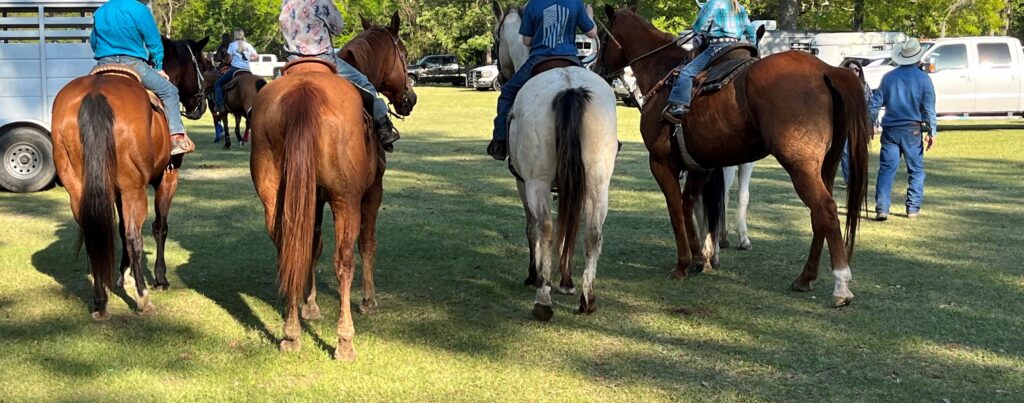
1. Base Coat Colors: The Foundation
All horse coat colors originate from three genetically defined base colors: bay, chestnut, and black. These are determined by two primary genes: the Extension (E) gene, which controls the production of black pigment (eumelanin), and the Agouti (A) gene, which determines where that pigment appears on the horse’s body.
More specifically, the MC1R (Extension) and ASIP (Agouti) loci are the genetic regions responsible for regulating the switch between red and black pigment in the equine coat.
Although these two genes establish the base coat, additional genes modify color through dilution, spotting, and shading—resulting in the rich spectrum of horse colors seen today.
Bay
Bay horses have a reddish-brown coat that ranges from light tan to deep mahogany, complemented by a black mane, tail, and lower legs—referred to as “points.”
- Genetics: Bay horses carry at least one dominant Extension (E) allele and one dominant Agouti (A) allele (E_/A_), which restricts black pigment to the points.
- Breeds: Common in Thoroughbreds, Quarter Horses, Morgans, and many warmbloods.
- Fun Fact: Bay is the most common horse coat color globally, accounting for approximately 35% of the equine population.


Chestnut (Sorrel)
Chestnut horses have a red-based coat that ranges from a pale golden hue (sorrel) to a dark liver chestnut. The mane and tail are usually the same shade as the body, with no black pigment present.
- Genetics: Chestnuts possess two recessive Extension (e) alleles (ee), which prevent the formation of black pigment. The Agouti gene has no effect in the absence of eumelanin.
- Breeds: Frequently seen in Arabians, American Saddlebreds, Haflingers, and draft breeds like Suffolks.
- Note: In Western riding circles, “sorrel” is commonly used for lighter chestnuts, but genetically they are the same.

Black
True black horses have a solid black coat, mane, and tail, though their color may appear sun-faded to dark brown in summer climates.
- Genetics: To express a black coat, a horse must carry at least one dominant Extension (E) allele and two recessive Agouti (a) alleles (E_/aa), allowing black pigment to cover the entire body.
- Breeds: Prominent in Friesians, Percherons, Shire, and gaited breeds.
- Tip: Some bay horses may appear almost black. Genetic testing is the most reliable way to confirm a horse’s true coat color.

Genetic Snapshot
| Base Color | Genotype | Description |
|---|---|---|
| Bay | E_/A_ | Brown body, black points |
| Chestnut | ee/_ | Reddish-brown, no black |
| Black | E_/aa | Solid black |
2. Dilution Genes: Creating Unique Shades
While bay, chestnut, and black form the foundation of horse coat colors, dilution genes modify these base colors to produce lighter or more unusual shades—like palomino, buckskin, dun, and champagne. These genes either dilute the intensity of red and black pigments or add specific characteristics, like primitive markings.
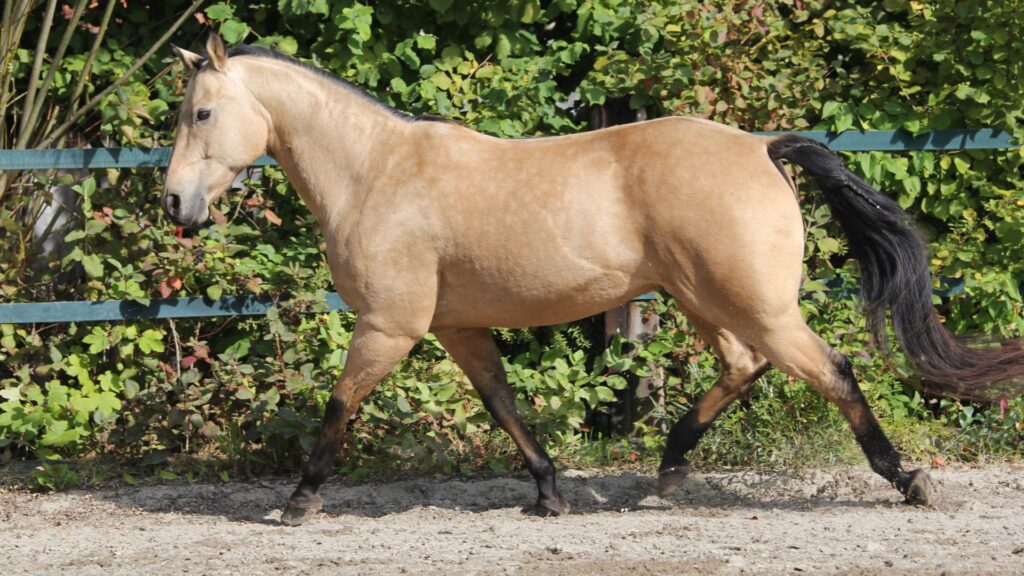
Cream Gene
Horses with the cream gene exhibit golden or cream-colored coats, often with striking eye and skin tones depending on whether they carry one or two copies.

- Examples:
- Palomino – Chestnut + one cream gene (ee/_/Cr_): Golden coat with white mane and tail.
- Cremello – Chestnut + two cream genes (ee/_/CrCr): Nearly white coat, blue eyes, pink skin.
- Buckskin – Bay + one cream gene (E_/A_/Cr): Tan or golden coat with black points.
- Perlino – Bay + two cream genes (E_/A_/CrCr): Creamy body with slightly darker mane and tail.
- Breeds: Common in Quarter Horses, American Paint Horses, and Morgans.
- Application: Palominos are prized in parades and exhibitions for their glamorous golden coats, often admired for their eye-catching color and shine.
- Dive deeper in our Color Genetics section.
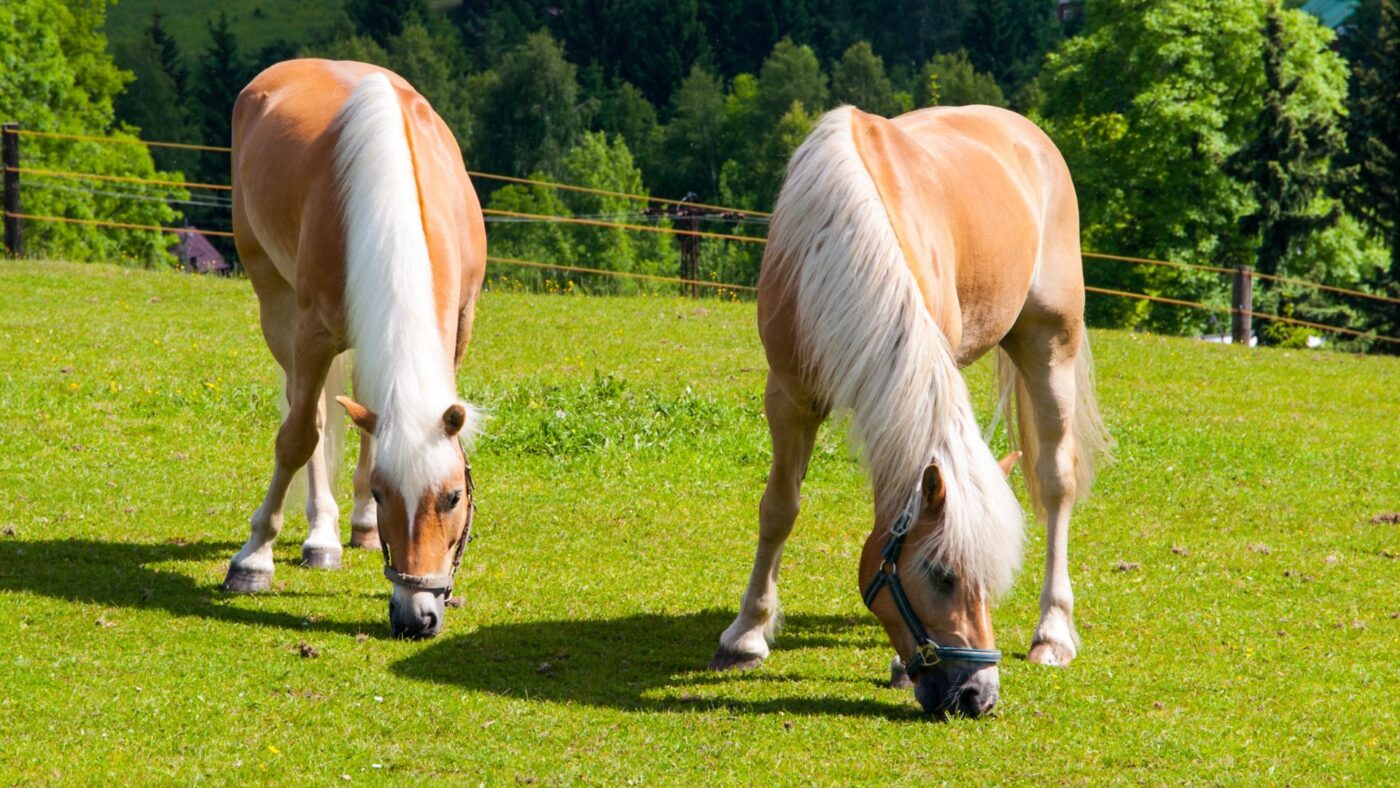
Dun Gene
- Effect: Lightens the body while retaining darker primitive markings (dorsal stripe, leg bars, shoulder stripes).
- Examples:
- Dun: Bay + dun (E_/A_/D_). Tan body, black points, dorsal stripe.
- Red Dun: Chestnut + dun (ee//D). Reddish body, red dorsal stripe.
- Grullo: Black + dun (E_/aa/D_). Slate-gray body, black points, dorsal stripe.
- Breeds: Common in Mustangs, Norwegian Fjords, and Quarter Horses.
- Evolutionary Note: Primitive markings suggest ancient camouflage, linking duns to wild horse ancestors.
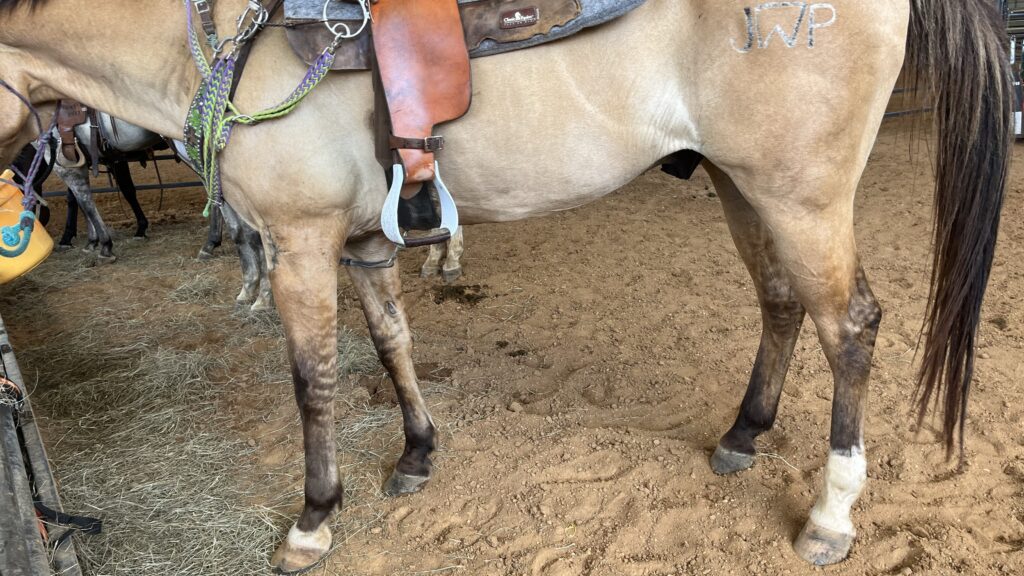
Champagne Gene
- Effect: Dilutes coats to gold, amber, or lilac shades with freckled skin and hazel eyes.
- Examples:
- Gold Champagne: Chestnut + champagne (ee/_/Ch_). Golden body.
- Amber Champagne: Bay + champagne (E_/A_/Ch_). Warm tan body, dark points.
- Classic Champagne: Black + champagne (E_/aa/Ch_). Lilac-gray body.
- Breeds: Rare, seen in Tennessee Walking Horses and Missouri Fox Trotters.
- Source: Discovered in the 1990s.
A missense mutation in exon 2 of SLC36A1 causes the champagne dilution phenotype.

Silver Gene
- Effect: Affects black-based coats, lightening the mane/tail to flaxen or silver.
- Examples:
- Silver Bay: Bay + silver (E_/A_/Z_). Brown body, flaxen mane/tail.
- Silver Black: Black + silver (E_/aa/Z_). Chocolate body, silver mane/tail.
- Breeds: Common in Rocky Mountain Horses and Morgans.
- Note: Does not affect chestnut-based coats.

Pearl Gene
- Effect: Creates a metallic sheen, often combined with cream for pseudo-double-dilute colors.
- Example: Pearl on chestnut (ee//Prl) produces an apricot-like coat.
- Breeds: Rare, found in Andalusians and Lusitanos.
- Rarity: Requires two pearl genes or one pearl + one cream for full expression.
Mushroom Gene
- Effect: Dilutes chestnut to a taupe or grayish-brown shade.
- Breeds: Primarily seen in Shetland Ponies.
- Research: Still under study, with limited genetic testing available.
Dilution Gene Chart:
| Gene | Base Color | Resulting Color | Notable Features |
|---|---|---|---|
| Cream | Chestnut | Palomino, Cremello | Golden or cream coat |
| Dun | Bay | Dun | Dorsal stripe, primitive markings |
| Champagne | Black | Classic Champagne | Freckled skin, hazel eyes |
| Silver | Black | Silver Black | Flaxen mane/tail |
| Pearl | Chestnut | Pearl | Metallic sheen |
| Mushroom | Chestnut | Mushroom | Taupe coat |
3. White Patterns: Striking Designs
White patterns overlay base colors, creating distinctive effects through genes that distribute white hair or patches.
Roan
- Appearance: White hairs mixed evenly with the base color, except on the head, mane, tail, and legs.
- Genetics: Dominant Roan gene (Rn_). Unlike gray, roan does not fade with age.
- Breeds: Seen in Quarter Horses, Appaloosas, and Belgian Drafts.
- Example: Blue roan (black + roan) has a bluish-gray body.

Appaloosa (Leopard Complex)
- Appearance: Spotted coat, often with a white blanket of spots on the hindquarters. Includes mottled skin and striped hooves.
- Genetics: Leopard complex gene (Lp_). Homozygous (LpLp) horses may have fewer spots.
- Breeds: Signature of the Appaloosa breed, also seen in Knabstruppers.
- Cultural Note: Prized by Native American tribes for their unique patterns.

Pinto Patterns
Types:
- Tobiano: White patches with smooth, rounded edges, typically crossing the topline (spine) and often resulting in white legs. Genotype may be TO/TO or TO/N.
- Overo: Irregular, jagged-edged white patches that usually do not cross the spine. Overo includes subtypes such as frame, splash, and sabino.
⚠️ Note: Frame Overo (O) is associated with Lethal White Overo Syndrome (LWOS). Breeding two carriers (O/O) may result in nonviable foals. - Sabino: White markings with roaning edges and high leg white. Sabino 1 (SB1) is linked to the KIT gene and shows increased white expression in homozygous horses (SB1/SB1).
Breeds:
Common in American Paint Horses and Gypsy Vanners, among others.
Tip:
Genetic testing through the American Paint Horse Association or UC Davis VGL helps accurately identify and differentiate pinto subtypes for breeding and registration purposes.

Gray
- Appearance: Progressive graying with age, starting from a base color (e.g., bay, black). Older grays may appear white.
- Genetics: Dominant Gray gene (G_). Linked to melanoma risk in some breeds.
- Breeds: Prevalent in Arabians, Lipizzaners, and Andalusians.
- Note: A gray foal may be born dark and lighten over time.
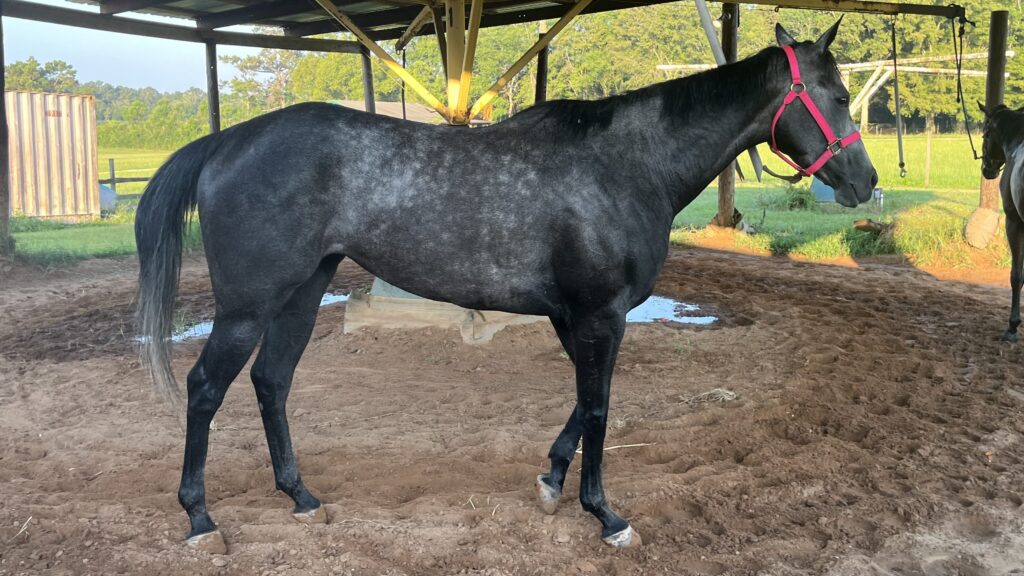
Dominant White
- Appearance: Nearly all-white coat with pink skin, often confused with cremello.
- Genetics: Dominant white gene (W_). Rare and breed-specific.
- Breeds: Found in Thoroughbreds and Arabians (e.g., Camarillo White Horse).
- Rarity: Less than 1% of horses carry this gene.
Some rare foals are born entirely white with pink skin—this can result from dominant white (W) variants or Lethal White Syndrome (OLWS), both involving the KIT gene. Although they appear similar at birth, the genetic implications differ significantly. Refer to Section 9 for a visual example and detailed explanation.

Rare Patterns
- Brindle: Striped pattern, extremely rare. Most cases result from somatic mutations or chimerism (two distinct DNA sets in one horse), as true inherited brindle is nearly nonexistent.
- Rabicano: White ticking on flanks and tail base, often subtle.
- Lacing: Grid-like white pattern on the back. The genetic basis is poorly understood, with no confirmed gene identified.
- Note: These patterns are so rare that genetic testing may not yet identify their causes.

4. Markings: Unique Identifiers
Horses often feature white facial and leg markings, adding individuality and aiding identification:
- Facial Markings:
- Star: Small white spot on the forehead.
- Blaze: Wide white stripe down the face.
- Snip: White patch between nostrils.
- Leg Markings:
- Stocking: White extending to the knee or hock.
- Sock: White up to the ankle.
- Pastern: White on the pastern only.
- Application: Markings are critical for breed registries and sales documentation.

5. Breed-Specific Genetic Quirks
Certain breeds exhibit unique genetic traits or limitations that affect coat colors and patterns [2]:
- Friesians: Almost exclusively black (E_/aa) due to selective breeding. Dilution genes (e.g., cream, dun) are absent, and white markings are minimal.
- Appaloosas: Defined by the leopard complex gene (Lp_). Homozygous (LpLp) horses may have vision issues (e.g., night blindness).
- Thoroughbreds: Exclude dominant white (W_) from registration. Bay and chestnut dominate due to breed standards.
- Andalusians: Often carry the pearl gene (Prl_), rare in other breeds, producing a metallic sheen.
- Suffolks: Exclusively chestnut (ee/_), a result of historical breeding for uniformity.
- Application: Breeders must consider these quirks when planning matings or registering foals.
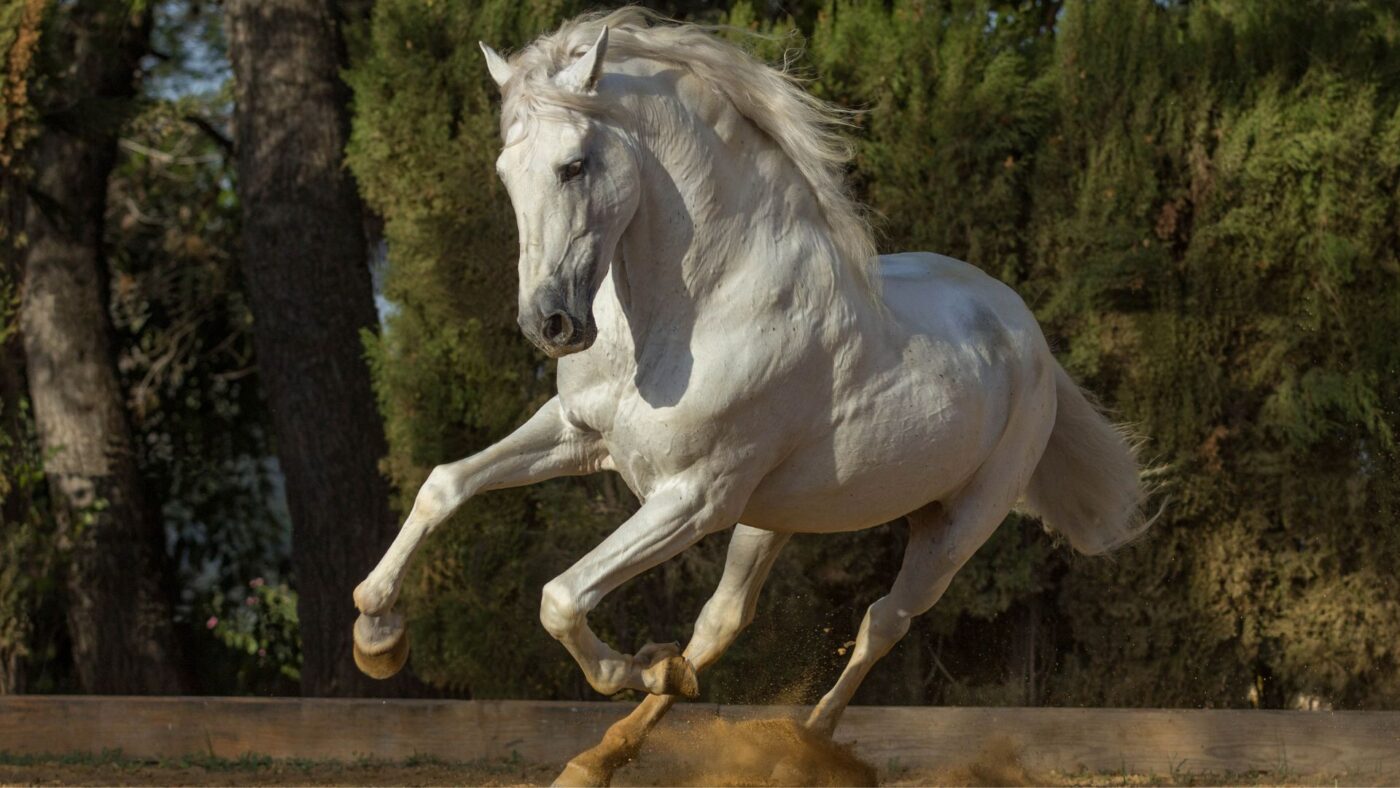
6. Genetics 101: Decoding Coat Color Inheritance
Horse coat color is determined by genetic interactions between base color genes and modifier alleles. Understanding how these genes combine helps breeders predict foal colors and avoid health risks tied to certain patterns.
Dominant vs. Recessive Genes
- Dominant alleles like Extension (E) and Agouti (A) only require one copy (from either parent) to be expressed in a horse’s coat.
- Recessive alleles, such as e and a, must be inherited from both parents to appear in the horse’s phenotype.
- For example, a bay horse has at least one dominant E and A allele (E_/A_), while a chestnut horse has two recessive e alleles (ee/_), resulting in no black pigment.
🧠 Note: The Extension (E) gene controls production of black pigment (eumelanin), while the Agouti (A) gene restricts that pigment to specific areas like the mane, tail, and legs.

This Punnett square illustrates how a Bay (EeAa) × Chestnut (eeAa) pairing can produce 50% Bay, 25% Chestnut, and 25% Black foals through combinations of Extension and Agouti alleles. Note: 🧬 A horse’s visual appearance doesn’t always reflect its full genetic makeup—DNA testing is the only way to confirm genotype.
🧪 Genetic Testing Guidance — UC Davis VGL Workflow
To help breeders make informed decisions, here’s a simplified workflow based on the UC Davis Veterinary Genetics Laboratory:
- Order the Coat Color Panel via MyVGL. It identifies genes for base colors and dilution modifiers, such as cream, dun, gray, silver, champagne, and mushroom, as well as patterns like roan, leopard complex, splashed white, and tobiano.
- Optional Add-On Panels: If your horse has white markings or complex patterns, consider the White Pattern Panel or Full Color/Pattern Panel for broader analysis. Results typically arrive in ~10 business days.
- Sample Collection: Pull 20–30 mane or tail hairs with intact roots. Follow the lab’s instructions and mail in a paper envelope (avoid plastic bags to prevent mold).
- Interpreting Results:
- Heterozygous (e.g., SW1/N): Horse carries one copy of the allele, with a ~50% chance of passing it on.
- Homozygous (e.g., SW1/SW1): Stronger phenotype expression and 100% transmission to offspring.
- Example: A splashed white carrier (SW1/N) mated to a non-carrier (N/N) will produce ~50% splashed white foals.
- Breeding Strategy:
- Use test results to match complementary genotypes and avoid risky pairings.
- Prevent inherited disorders (e.g., Lethal White Syndrome or congenital deafness) by ensuring carriers aren’t bred together.
Bottom line: With the right genetic knowledge and testing strategy, breeders can combine aesthetics, health, and predictability in future generations.

7. Practical Applications of Coat Color Knowledge
- Breeding: Selecting for colors like palomino requires understanding gene probabilities. Homozygous cream horses (CrCr) always pass one cream gene, ensuring diluted foals.
- Show Eligibility: Some breeds restrict colors (e.g., Thoroughbreds exclude dominant white). Check breed registries for rules.
- Market Value: Rare colors (e.g., champagne, brindle) can increase a horse’s value, while common colors like bay are versatile.
- Cultural Significance: Colors like gray (wisdom) or palomino (glamour) hold cultural weight in shows or parades.
Tip: For the most accurate color identification and breeding predictions, consult with your veterinarian or a genetics lab before making decisions.

8. Frequently Asked Questions (FAQ) About Horse Colors and Patterns
🐴 General Horse Coat Color FAQs
These questions address the most common curiosities, myths, and practical insights about horse coat colors, especially helpful for casual owners, riders, and beginners.
Can horse colors change over time?
Yes, gray horses progressively lighten as they age and often appear white in maturity. However, most other colors remain genetically stable. Seasonal changes such as sun bleaching or coat shedding may cause temporary shifts in appearance.
Does a horse’s coat color affect its health?
Yes, certain colors and patterns carry health implications. For example, Overo-patterned horses that inherit two copies of the Overo gene can develop Lethal White Overo Syndrome (LWO), a fatal condition affecting the intestines. Additionally, gray horses are at increased risk for melanomas, particularly as they age.
What determines a horse’s coat color?
A horse’s coat color results from the interaction of base genes (like Extension (E) and Agouti (A)) and modifier genes, such as dilution or spotting genes. These modify the expression and distribution of pigments like eumelanin and pheomelanin.
Are white horses albino?
No. True albinism—complete absence of pigment—is virtually nonexistent in horses. Most “white” horses are actually gray or carry a dominant white gene that causes depigmentation but retains eye and skin pigment.
What’s the rarest horse color?
Among the rarest are brindle (often the result of chimerism), dominant white, and unusual dilution-related shades like mushroom and pearl. These colors often appear only in certain breeds or under rare genetic conditions.
🧬 Genetics, Identification & Breeding FAQs
These questions are for readers interested in the genetic mechanics behind coat colors and how to distinguish or test specific traits.
Can two horses of the same color produce a foal of a different color?
Yes! Horses can carry recessive genes that don’t affect their own coat color but can show up in offspring if both parents pass down the same hidden allele. For example, two chestnuts may produce a palomino if both carry the cream gene.
What’s the difference between a roan and a gray horse?
A roan horse has white hairs evenly mixed with its base coat from birth, and the pattern remains stable throughout its life. A gray horse, however, is born a solid color and progressively lightens with age due to the gray gene. Over time, gray horses often appear nearly white.
How can I tell if my horse is a dun or a buckskin?
Dun horses have primitive markings such as a dark dorsal stripe, leg barring (zebra stripes), and shoulder shading. Buckskins have a cream-diluted tan coat with black points but no primitive markings. A DNA test can confirm whether the horse carries the dun (D) or cream (Cr) gene.
What’s the difference between Pinto and Paint?
“Pinto” refers to a coat pattern—irregular white and colored patches. “Paint” refers to the American Paint Horse breed, which must have Quarter Horse or Thoroughbred bloodlines in addition to pinto coloring. Learn more here.
How do I test my horse’s coat color genes?
You can order a DNA test from UC Davis Veterinary Genetics Lab or other accredited labs. Typically, you’ll collect hair samples with roots and send them in for analysis of specific genes like cream, champagne, or dun.
Why does my bay horse look reddish?
Some bay horses appear more reddish or coppery due to genetic modifiers, seasonal coat changes, or sun bleaching. This doesn’t alter their underlying genotype (E_/A_), which still classifies them as bay.
Can two chestnut horses produce a black foal?
No. Two chestnut horses (ee) cannot produce a black foal because neither carries the dominant Extension allele (E) required for black pigment production.
9. Emerging Research & Complex Genetic Interactions
Recent equine genomics studies reveal that coat color is shaped by interactions among multiple genes, regulatory elements, and novel mutations—beyond the classic single-gene models.
KIT‑Based White Allelic Diversity
Over 40 dominant-white (W) variants have been identified at the KIT locus, such as W34, W35–W39, each contributing varying degrees of white spotting—from sabino-like legs to extensive depigmentation. For example, W34 intensifies white expression when paired with chestnut MC1R (e/e).
TBX3 Regulatory Mutations Affect Dun Expression
The non-dun phenotype arises from regulatory mutations near the TBX3 locus that alter its expression in hair follicles. These changes disrupt pigment deposition asymmetry in hairs, explaining why two horses with the same genetic mutation can display different “dun” intensities.
Gene–Gene Interactions & Phenotypic Modifiers
Emerging evidence shows that regulatory elements near KIT, or modifier variants in TBX3 or EDNRB, can amplify or suppress white spotting patterns—even among horses carrying identical primary mutations. These modifiers fine-tune the phenotype expression in complex ways.
Solid White Foals: Dominant White vs. OLWS

The genetics behind solid white foals with pink skin—like the one pictured (Figure wp-image-40683)—are complex. Some carry dominant white variants (W34–W39), while others may be carriers of Lethal White Syndrome (OLWS), both linked to the KIT gene. Although both produce all-white coats, dominant white (W_) may cause congenital deafness in some cases, while OLWS leads to fatal digestive issues. Peer-reviewed research supports comprehensive DNA testing (e.g., UC Davis VGL’s White Pattern Panel) to avoid misdiagnosis and inform ethical breeding. See Section 6 for test recommendations.
📌 Bottom Line for Breeders & Enthusiasts
Coat color inheritance in horses is far from straightforward. It involves layered systems of interacting primary genes, modifier elements, and newly discovered alleles. Genetic tests should include the latest variants (e.g., W34–W39, non-dun
10. Resources
For further exploration, here are trusted resources on equine coat colors and genetics:
- UC Davis Veterinary Genetics Laboratory: Offers DNA testing for coat color genes like cream, dun, and champagne [3].
- Animal Genetics: Provides genetic testing for equine coat colors and patterns [10].
- “Equine Color Genetics” by D. Phillip Sponenberg: A comprehensive book on equine coat color science (available at major retailers) [2].
- American Paint Horse Association (APHA): Resources on pinto patterns and breed standards [8].
- Appaloosa Horse Club: Information on the leopard complex and Appaloosa standards [11].
11. References
- Sponenberg, D. P., & Bellone, R. (2017). Equine Color Genetics. Wiley-Blackwell.
- Sponenberg, D. P. (2009). Equine Color Genetics, 3rd Edition. Wiley-Blackwell.
- UC Davis Veterinary Genetics Laboratory. (2023). Coat Color Testing. https://vgl.ucdavis.edu/services/coat-color
- Bailey, E., & Brooks, S. A. (2013). Horse Genetics. CABI Publishing.
- Cook, D., et al. (2008). “Missense Mutation in Exon 2 of SLC36A1 Responsible for Champagne Dilution in Horses.” PLoS Genetics, 4(9), e1000195. https://doi.org/10.1371/journal.pgen.1000195
- Holl, H. M., et al. (2017). “A Novel Missense Variant in SLC45A2 Associated with Dilution in Shetland Ponies.” Animal Genetics, 48(4), 499–500.
- Rieder, S. (2009). “Molecular Tests for Coat Colors in Horses.” Journal of Animal Breeding and Genetics, 126(6), 415–424.
- American Paint Horse Association. (2023). Coat Color Genetics. https://apha.com/coat-color-genetics
- Sponenberg, D. P. (2000). “Brindle in Horses: A Rare Phenomenon.” Journal of Equine Veterinary Science, 20(5), 326–327.
- Animal Genetics. (2023). Equine Coat Color Testing. https://www.animalgenetics.us/Equine/Coat_Color/CoatColor.asp
- Appaloosa Horse Club. (2023). Appaloosa Characteristics. https://www.appaloosa.com/about/characteristics

12. Explore More
- Share Your Horse: Post a photo of your horse’s coat on X with #HorseCoatColors to join the conversation.
- Stay Updated: Bookmark this page for updates on new genetic discoveries, and share your questions in the comments below!
Interactive Horse Coat Color Tool
To help you better understand and identify horse coat colors, we’ve developed an interactive tool. This tool allows you to select various genetic traits and see the potential resulting coat colors, giving you a dynamic way to explore the principles discussed in this guide. It visually demonstrates coat color outcomes based on combinations of Extension, Agouti, dilution, and pattern genes.
Important Note: This interactive tool provides a predictive guide to horse coat colors based on genetic possibilities. For definitive identification and crucial breeding decisions, DNA testing by a reputable equine genetics laboratory is highly recommended.
Want a quick way to spot horse coat colors? Download our printable Horse Color Chart, packed with color swatches, genetic codes, and breed examples like bay Thoroughbreds and spotted Appaloosas. Preview it below to see shades from chestnut to champagne.
Printable Horse Color Genetics Chart: 15 Common Coat Colors with Swatches & Codes
Seen the chart? Test your knowledge with our fun color quiz below!
Test Your Horse Coat Color Knowledge!
Think you know your bays from your buckskins? Ready to spot a sabino or a silver dapple? Take our quick, fun quiz now and see how much you’ve mastered about horse coat colors and patterns!
Perfect for beginners and seasoned equestrians alike. Challenge yourself and learn something new!
💬 Did you ace the quiz? Share your score and your horse’s coat color in the comments below!
Quick Reference: Health Concerns Linked to Specific Horse Colors & Patterns
While most horse colors are simply beautiful, a few are linked to specific health risks. Here’s what to know:
| Color/Pattern | Health Risk(s) | Prevention/Notes |
|---|---|---|
| Frame Overo (Pinto) 🧬 | Lethal White Syndrome (OLWS) ⚠️ | Test for OLWS gene before breeding |
| Gray 🧬 | Melanoma (esp. after age 15) ⚠️ | Monitor for tumors, esp. under tail/genitals |
| Appaloosa (Leopard Complex) 🧬 | Moon blindness (ERU), Night blindness (CSNB) ⚠️ | LP/LP horses at highest risk; genetic testing |
| Splashed White (Pinto) 🧬 | Congenital deafness ⚠️ | Test for splashed white gene variants |
| Dominant White 🧬 | Congenital deafness (some breeds) ⚠️ | Genetic testing available |
| Cremello, Perlino, Double Dilutes | Photosensitivity, sunburn 🌞 | Provide shade, fly masks/sunscreen |
| Champagne, Light-skinned Dilutes | Increased sun sensitivity 🌞 | Monitor for burns, protect light areas |

Registration Color Requirements by Breed
Certain horse breeds have specific color restrictions for registration, often reflecting the breed’s historical development and desired characteristics. Here’s a quick reference table:
| Breed | Allowed Colors | Disallowed Colors |
|---|---|---|
| Friesians | Black only | Chestnut, bay |
| Thoroughbreds | Bay, black, chestnut | Appaloosa, pinto |
| Arabians | Bay, chestnut, black, gray, roan | Dun, champagne (purebreds)* |
| Paints | Pinto patterns | Solid colors (no white) |
| Appaloosas | Spotted patterns | Solid colors (no spots) |
| *Note: Half-Arabians may exhibit champagne if crossed with breeds carrying the gene. |
📥 Download our free Horse Color Chart, try the interactive quiz, and tell us in the comments: What’s the most unique coat color you’ve seen—or what color is your own horse?
🐴 Keep exploring with our Palomino Horse Guide or dive into Thoroughbred Genetics to see how color connects to performance and pedigree.
Bookmark this guide as a reference—and keep learning as new discoveries emerge!

About the Author: Miles Henry
Lifelong Horseman | Racehorse Owner | Published Author
Miles Henry brings over 25 years of hands-on experience training and owning Thoroughbred racehorses. Raised with Quarter Horses and Appaloosas, he’s spent a lifetime learning from horses—on the track, in the barn, and in the field. Today, he runs a small but successful racing stable in Louisiana and shares real-world insights on HorseRacingSense.com, helping horse owners, fans, and bettors navigate the sport with confidence.
📚 Books: View Miles’s books on Amazon »
🎧 Podcast Guest: Animal Tales Ep. 32 |
YouTube Interview
📩 Newsletter: Sign up for racing tips and horse care advice »
🔗 Follow Miles:
Twitter |
Facebook |
YouTube

